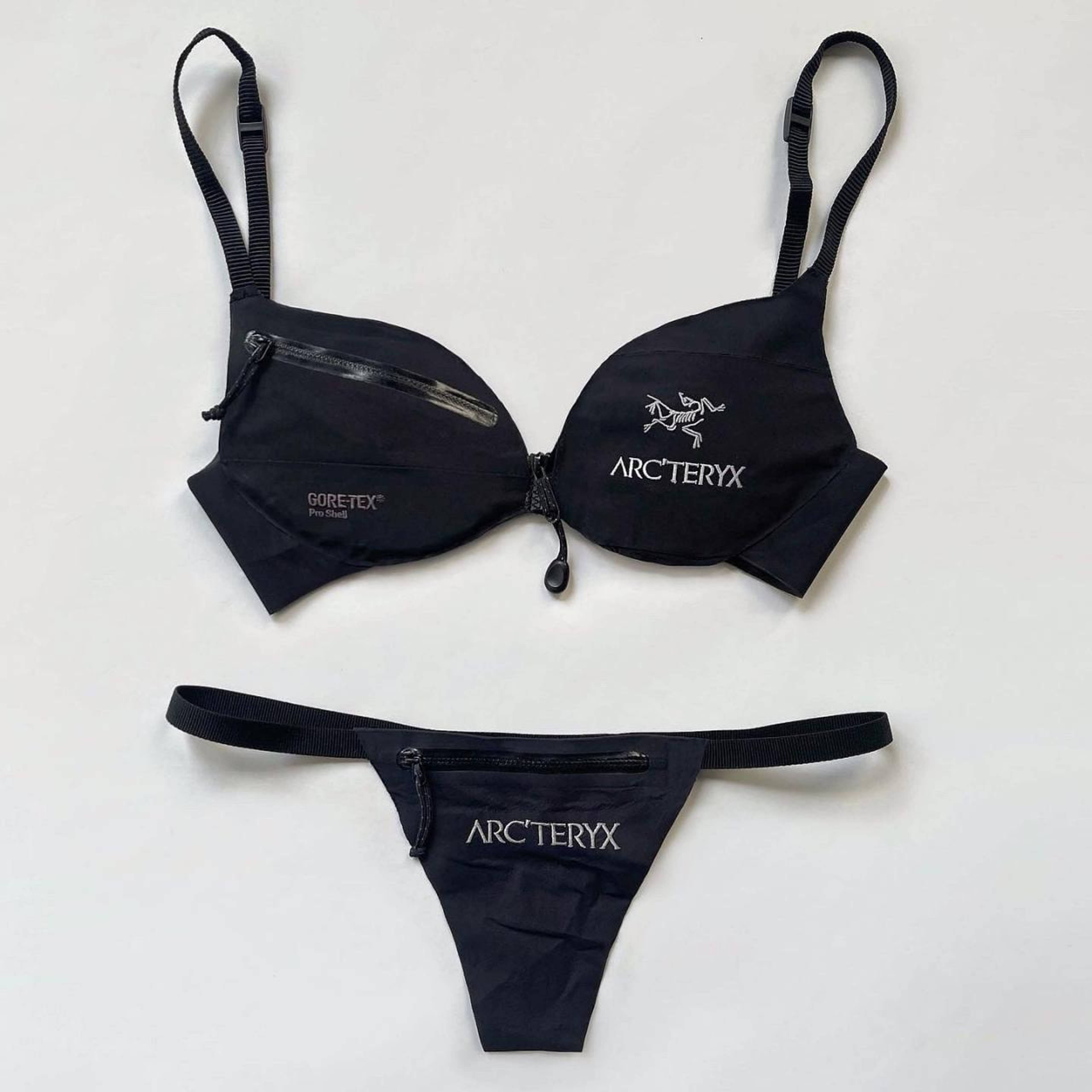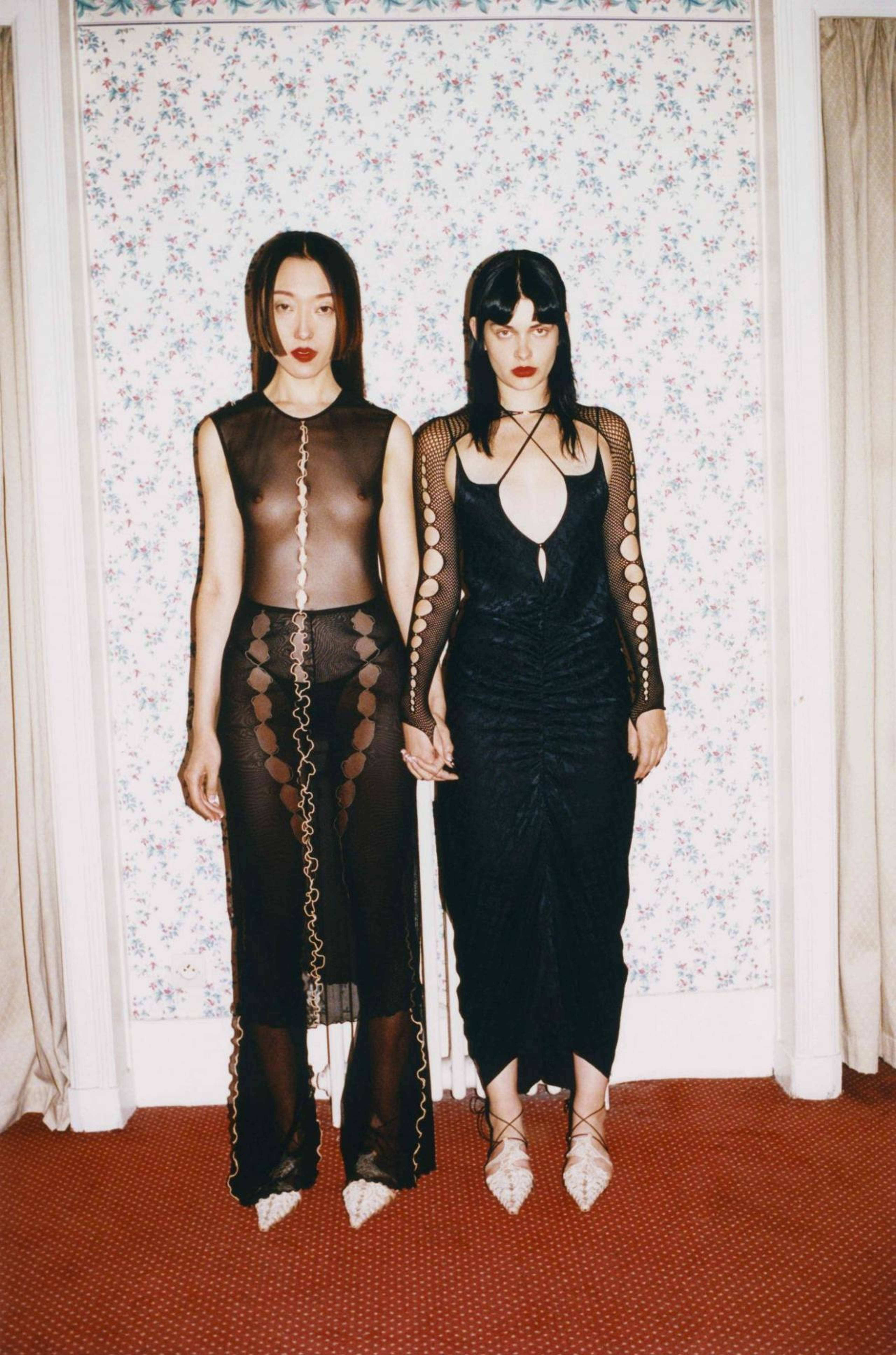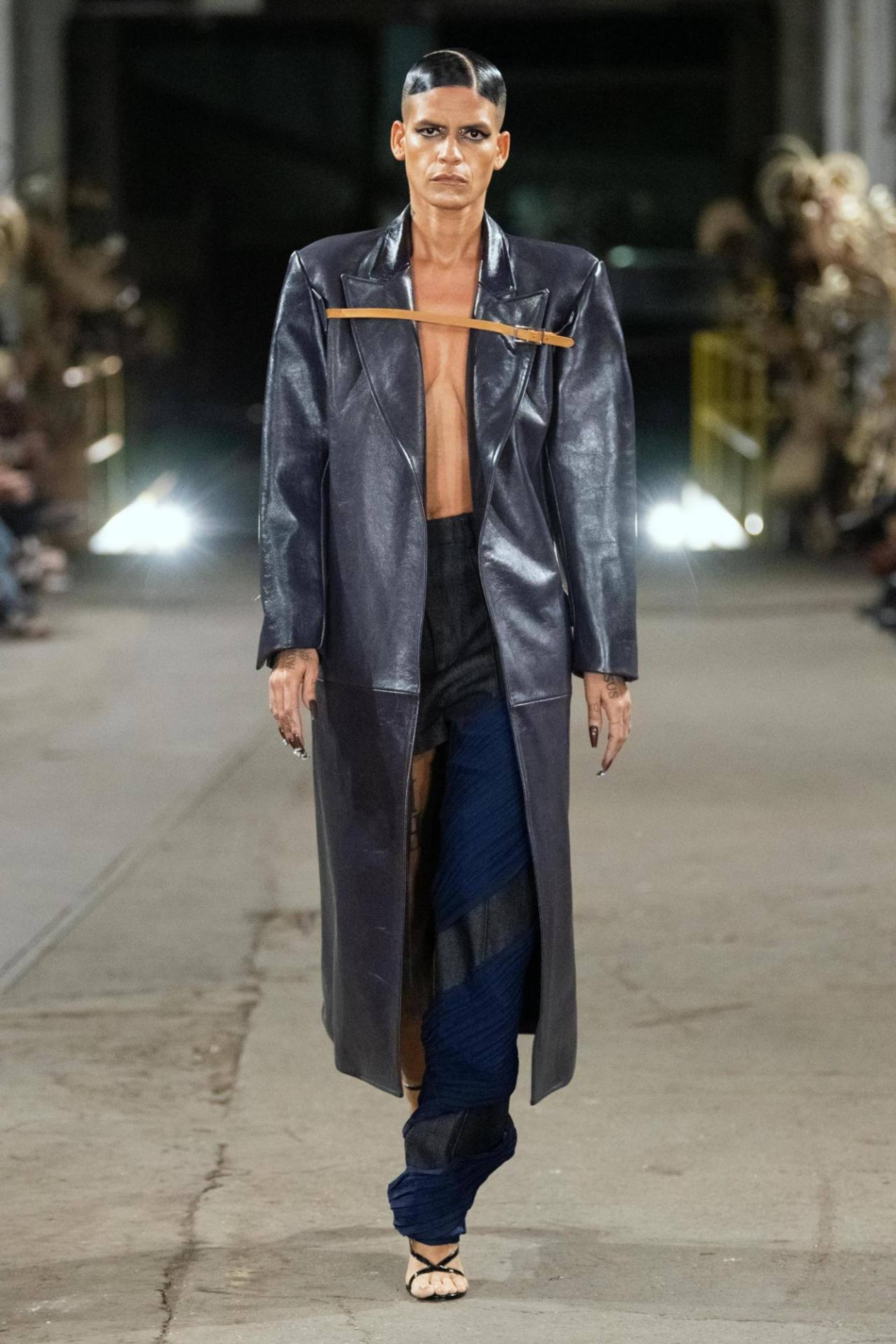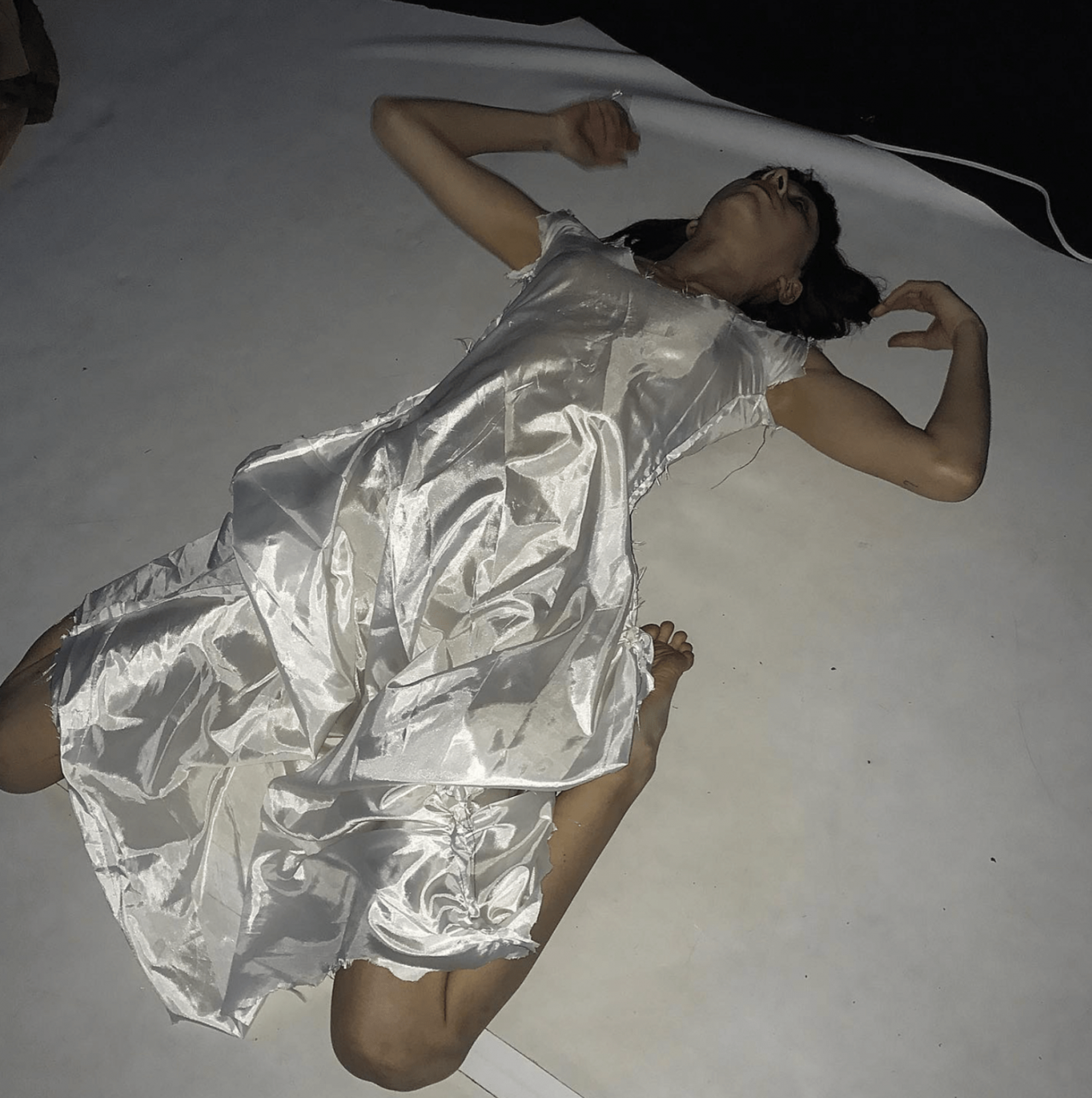The diagnosis came from Steff Yotka’s Vogue review of Eckhaus Latta’s Spring 2022 Ready-to-Wear collection: “a parade of sleek, honest, horny garments that lusts for the human body in a sort of clinical way”. As soon as I read the assessment, other trending sartorial conditions came to mind – similar symptoms of a widespread case of clinical horniness .
Clinical horniness marries the austerity of the medical institution with a libidinal alacrity:
• Bitchy hardware that calls to mind the heartless sheen of surgical tools: Luar coats with incisive buckles, snap-off clothing à la Merritt Meacham or Agnès B., metallic O-ring Versace tops and the rash of SHEIN-ian variants
• Gore-tex fetishisation/ obsession with preparing for intense wetness (Arc’teryx and adjacent “high performance active wear” …)
• Workwear and blue-collar stolen valor (horny because, as James Russell Lowell wrote in 1843: “blessed are the horny hands of toil”, and clinical because it postures utilitarian)
• Kim looking like a black latex surgeon’s glove at The Met
• Silver sneakers (e.g. the New Balance 860 V2s in silver and white aptly described by Blackbird Spyplane’s Jonah Wiener as “raver nurse shoe”)
• Freshly sutured look of skin tight cut–outs and laced-up thotwear
• Wound dressing-esque gauze garments
I see it too as an amorphous aesthetic category. The cold, steely excitement present in things like: chewing gum in pellet form (esp. Dentyne Ice in the flavour Arctic Chill); the kind of industrial door handle that is a metal bar you push; the perforated strip of hard plastic on the bottle caps of mouthwash; perforation at large; cubic zirconia stud earrings; monthly payment plans; installments at large; VOSS water; handheld vacuum cleaners; vacuums at large; sucralose; the letter K; when you press and hold apps on your home screen and they gyrate frantically.
Eckhaus Latta Spring 2022 Ready-to-Wear. Photo: Michael D. Subrizi
“What does clinical even mean?” my friend, Fanny, messages. I’d sent a voice note asking if Fanny felt a video of a woman impaling a cake with an upturned vase in order to extract a cylindrical slice struck her as clinically horny. Fanny answers her own question with a screenshot of Siri’s response: “clinical: adj. 1) relating to the observation and treatment of actual patients rather than theoretical or laboratory studies. 2) very efficient and without feeling”, then Fanny says: “Doesn’t definition 1 seem so directly opposed to definition 2!!??” before deciding clinical horniness is one of those terms that seem like it should have obvious meaning but is ultimately an optical illusion of the mind.
Another friend has a similar response when I try to make a case for the intro to The Daily being clinically horny. My argument hinges specifically on the phrenetic cadence with which Michael Barbaro announces the date (“it’s WEDNESDAY, January NINETEENTH”). “Define clinical and also horny”, Willard responds. He is wearing a shirt from an early 2010s Agnès B. x Ryan McGinley collaboration: a white, long sleeve cotton crewneck with a self-portrait of McGinley puking. The POV is such that the projectile vomit takes on a phallic form and, from afar, the photo often strikes me as depicting a blowjob. Horny illusion, clinical condition …
The draining of romance from the horny narrative, the detached efficiency with which we can get off , is often blamed on technological advancements – but we can’t blame the fabric for the outfit.
Clinical horniness is hard to explain precisely because it stems from a struggle to articulate an interior state – it is the stilting of carnal desire in a sterilised world, a fitting affliction for what Rachel Tashjian described in her GQ review of the pivotal Eckhaus Latta show as “the erotic, momentarily urgent physicality brought on by the last two years”. Unprecedented isolation combined with fear of imminent death is both an aphrodisiac and an anesthetic.
In Jean-Paul Sartre’s “The Wall” (1939), the main character – a man imprisoned and on death row – alternates between states of heightened physical stimulation and complete numbness. Pablo Ibbieta perceives his body as “a colossus to which he is bound but with which he feels no kinship”. Driven to a state of “tender complicity”, he feels both “terribly hard” and yet unable to feel his own body. Faced with the crisis of world collapse, the body is reduced to a matter of fact; its accompanying needs become silly mechanical compulsions to be dutifully plugged into an algorithm for calculated satisfaction. Precise like a snap-off cardigan.
RUI SS22 editorial. Photo: Liu Xiangyu
The automatisation of intimacy is a ubiquitous burlesque. I order cauliflower rice sushi from a place with cardboard takeout boxes that claims, on each lid, to be: “hand rolled with love”. My dermatologist fills prescriptions through an app that immediately sends me a text from a robot pharmacist who signs off: “love, Sonia”. After online-purchasing a tennis skirt from aloyoga.com, I get an email with the subject line: “You love Alo”. A boy texts a kissy face emoji but the one with just the lips puckering, no heart emerging from the mouth. I google “what does it mean kissy face no heart”. “Sentiments of love and affection”, Emojipedia tells me, but it could also be “a person casually whistling after wrongdoing, saying: nothing to look at here.”
In The Body in Pain: The Making and Unmaking of the World (1987), Elaine Scarry unpacks the abovementioned Sartre story. Of Ibbieta’s aimless alternation between a state of “shrill sentience” and a body that is “mute and insensate”, Scarry says there is nothing “intriguingly paradoxical, or even puzzling about this duality: the two simply belong together” given that “the body, this intensely alive tissue is also the thing that allows Ibbieta, or anyone, to be one day dead.” Flirtation and indifference are the same emoji. Is this dehumanising or just putting humans in their place?
Luar SS22 runway
The draining of romance from the horny narrative, the detached efficiency with which we can get off , is often blamed on technological advancements – but we can’t blame the fabric for the outfit. I often think about a girl in high school who dressed up as an iPhone one Halloween. She wore a giant cardboard box with a cut out only for her head. At lunch, the girl fell down the stairs. With her arms trapped in the box, she couldn’t break her fall and fell flat on her face. I heard about the accident from the girl’s friend. The friend, also donning cardboard, was dressed as an electrical socket for a couples costume with her boyfriend, who went as a plug. The lesson here is something about the danger of getting trapped in a phone, something about dressing as an outlet for connection. Even within our technological boxes, we can stay labile.
For Prada’s latest fragrance campaign, actor Jake Gyllenhaal sets sail on the Prada Luna Rossa racing yacht for a short film of water droplets dripping off his body and Prada gore-tex jacket. Luna Rossa Ocean celebrates “humanity augmented by technology”, Prada says. Gyllenhaal calls the boat an “expression of technology and artistry”, assuring Vanity Fair that it “actually sails. It’s not just some idea of adventure. It’s for real – even though there's a fantasy part of it. I think the fragrance is about people who want adventure and want to be active, not only externally but also within themselves.”
Due to a series of Fashion Week logistical faux-pas, Eckhaus Latta’s September show was delayed by an hour. The postponed start-time meant their “parade of sleek, honest” garments lusted for the human body at dusk. As daylight faded over Bushwick, the runway ignited with deconstructed mocknecks and brutalist knitwear. The scene conjures a foundational contribution to the clinically horny canon, the opening lines of T.S. Eliot’s “The Love Song of J. Alfred Prufrock” (1915):
“Let us go then, you and I,
When the evening is spread out against the sky
Like a patient etherized upon a table …”
SparkNotes describes Eliot’s dramatic monologue as “an examination of the tortured psyche of the prototypical man – overeducated, eloquent, neurotic, and emotionally stilted. Prufrock, the poem’s speaker, seems to be addressing a potential lover, with whom he would like to ‘force the moment to its crisis’ by somehow consummating their relationship.” The poem opens at sunset – a quintessentially romantic backdrop – except that the sun has been drugged senseless on a hospital bed. The poem proceeds with a feeling of overwhelming loneliness and ennui, describing a world gutted of meaning, a life reduced to a series of snack times. In the last few stanzas, there is a tonal shift. Prufrock moves from anemic irony to something vivid and fantastical. He hears mermaids sing and walks along a seashore, things seem to be going well “till human voices wake us, and we drown.” If only he’d had a waterproof garment engineered with a proprietary lightweight and breathable fabric. Maybe Prufrock could have lived to consummate in a Visvim anorak.
Merritt Meacham, “Moon Dressed”. Photo: Merritt Meacham






